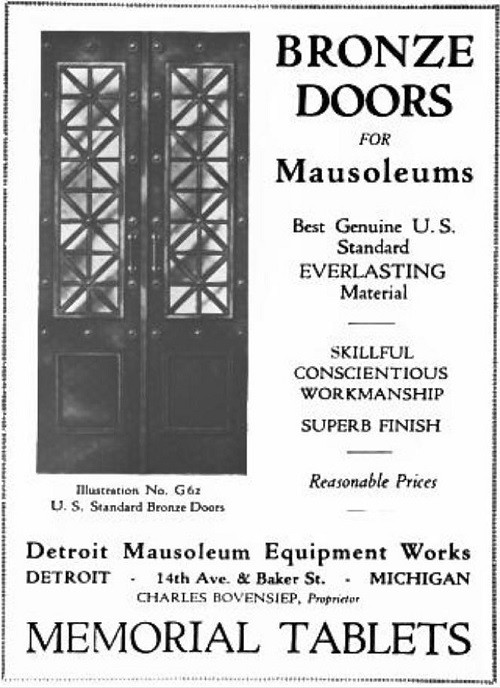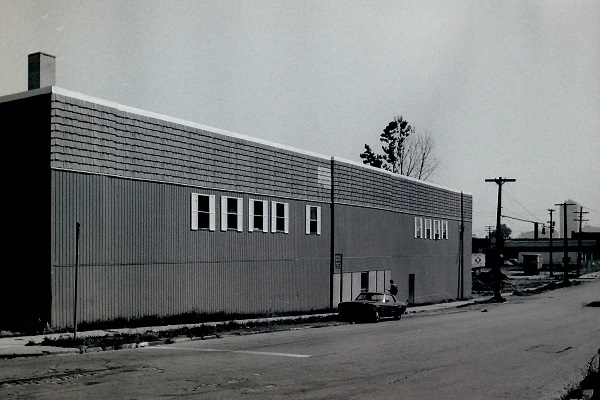
The structure sits on two lots of the former Godfroy farm--numbers 97 and 100--which combined measure 145 feet on Bagley and 103.94 feet on Fourteenth. Before it was built, five one-story wood houses stood here, having probably been constructed in the 1870s or 1880s. The current building was originally a two-story factory with offices located in the front-center. Although city records state that it was constructed in 1933, the building permit (#19537) was actually issued on June 8, 1921. Originally there were two business listed at this address.
Detroit Mirror Works
The Detroit Mirror Works was founded in 1897 by George Wangbichler. He was born in Germany in 1869 and came to the United States in 1888. Prior to moving to this location, the Detroit Mirror Works business operated at the corner of Porter and 4th Streets. At the time, Wangbichler was a resident of Grosse Ile.

Advertisement from the 1921 Detroit city directory.

Photo from Mr. and Mrs. George Wangbichler's passport, issued in 1923.
Image courtesy Ancestry.com.
In 1923, Wangbichler retired, having sold his business to William A. Richards and Frederick W. Weber. In May of 1930, Richards bought out Weber's share of the company and became the sole owner. The name was later changed to the Detroit Mirror & Glass Company.
Detroit Mausoleum Equipment Works
The other business that first occupied this factory was the Detroit Mausoleum Equipment Works, founded by Charles Bovensiep Jr in 1911. He too was a native of Germany, born in 1871 and immigrated in 1882. The Detroit Mausoleum Works manufactured exclusively bronze doors and plaques for mausoleums and other memorials. Before moving to this site, the company previously occupied a building on Fort Street and Second Avenue.

Advertisement from Granite, Marble & Bronze, October 1922.

Photo from the Detroit Free Press, March 20, 1910.
Both the Detroit Mausoleum Equipment Works and the Detroit Mirror & Glass Company occupied this building until the early 1940s.
Tragedy
By the mid-1940s, the building was occupied by the C. & P. Metal Co. and the National Tent & Awning Company. At the time, National Tent was manufacturing canvas coverings for army vehicles.
At 2:30 p.m. on December 5, 1944, a fire broke out in the sewing room of the National Tent & Awning Company. Before long it had become a five-alarm blaze, fueled by stockpiles of canvas and engulfing the entire building.

Source: Detroit Fire Department Apparatus History by Matthew Lee.
Many of the company's thirty employees were on the second floor when the fire occurred, and had to escape by jumping out of windows. According to the Detroit Free Press, employee Leonard J. Clark carried four of his coworkers down a fireman's ladder. Tragically, three women did not escape in time: Frances Spencer, 44, Bessie Daisley, 52, and Merry Rolston, 38.

Source: Detroit Free Press, December 6, 1944.
In addition to the three who lost their lives, three other employees were injured when escaping the building. It was believed that smoking in a prohibited area of the factory caused the fire. The Free Press reported that the building was "almost completely demolished"--although it appears that the brick facade was left intact. The flames were so intense that firemen needed to spray water between the building and the recently-completed U.S. Postal Service garage next door to prevent the fire from spreading.

Photo from Detroit Free Press, December 6, 1944.
File source: Detroit Historical Society..
There was evidently a second fire in this building on February 17, 1947, when it operated as a distribution center for radio manufacturer Philco, Inc. According to the Detroit Fire Marshall's Annual Report of 1947, damages exceeded $350,000.00.
Rebuilding
After multiple renovations and repairs, 2150 Bagley was occupied by the Century Bar & Restaurant Equipment Company by 1949.


Image courtesy City of Detroit.
This image is from the 1950 edition of Sanborn's fire insurance maps of Detroit:

Image courtesy Sanborn Maps.

Aerial view of 2150 Bagley looking north, circa 1965.
Courtesy Detroit Historical Society.

Aerial view of 2150 Bagley looking east, circa 1965.
Courtesy Detroit Historical Society.
At some point the factory was sheathed in a bizarre combination of wood shakes and aluminum siding, as seen in this 1976 photo.

Image courtesy Michigan State Historic Preservation Office.
One year after this photo was taken, owner Charlotte Hamilton sold the property to George J. Ondik and his wife Josephine M. Ondik. The Ondik family is still connected to the property.
Decline
Much of the odd siding seen in the 1976 photos has since been removed. However, the building--now ninety-three years old--has deteriorated severely in recent years.

One business that has operated here more or less continuously since 1977 is an optical company founded by George Ondik. Originally incorporated in 1960 as Cameo Optical, this optometry service has been run by members of the Ondik family under various names--Bagley Vision, Bagley Optical, Corktown Optical, Park Bagley Corp, Park Bagley LLC, Opt T Optical, and Precision Optical. The property owner today, as indicated by tax records, is Park Bagley LLC. The LLC's listed agent is West Bloomfield resident Donna Tarnas, a daughter of George Ondik.
This building has gained notoriety for its intermittent use as an illegal after-hours club. The following incident, reported by the Detroit Free Press, is only a recent example:
46 people cited, drugs found during raid
A raid on a southwest Detroit blind pig early Sunday resulted in several arrests, the impounding of numerous vehicles and the confiscation of illegal drugs.
The raid by the Wayne County Sheriff's Office occurred about 4 a.m. at 2214 [sic] Bagley and was in response to complaints about noise, after-hours illegal alcohol sales and drug use, according to a news release from the Sheriff's Office.
In all, 46 individuals were cited and 25 vehicles were impounded. Various amounts of cocaine and marijuana were confiscated, as well as one handgun, the release said.
Investigators said they believe the blind pig has been running for months and had been the subject of a previous raid. (Detroit Free Press, 3/5/2012)
On the day that news story was published, George Ondik filed to organize Bagley Avenue Properties LLC. Three weeks later, on March 28, 2012, he filed a quit-claim of the property with Wayne County designating the LLC as the grantee. Potential buyers would be well advised to ensure a clean title by obtaining title insurance when attempting to purchase this or any other property.
In addition to decay and illicit uses, 2150 Bagley is beset by yet another problem: tax foreclosure. Taxes have not been paid on this building in several years, and together with fees and interest they total over $30,000.00. On March 1, 2013, the Wayne County Treasurer initiated the foreclosure process by issuing a certificate of forfeiture for nonpayment of 2011 taxes.
Despite this building's serious issues--and despite the aggravation of having spent five years of my life living next to a two-story code violation that emitted techno music--there is something I love about this building. Maybe it's the sound of the passing trains, its very close proximity to Honeybee Market, or the proper urban street wall formed by the facade. Or maybe I'm just a hipster who thinks that living in a repurposed factory is "cool." Whatever it is, I sincerely hope that a wise and capable investor rescues this living artifact of our neighborhood's history.
Interested parties should contact O'Connor Realty at (313) 963-9891.


Wonderful blogging - I've enjoyed reading your posts.
ReplyDelete^^^ Agreed. I check back all the time to see if you've posted anything new.
ReplyDeleteI used to live in this building, and was present in the building (though not at the party) when the blind pig was raided. That place was wild. George took that old, run down factory, and turned it into makeshift "lofts" that he rented for residential purposes. On more than one occasion, I encountered animals that weren't my own inside my living unit (a neighborhood dog who was most unfriendly, and a possum on a separate instance). There was a local band who used one of the spaces for practice, and several other local bands often practiced there as well. I remember once that George was trying to capture a squirrel who had made a hole in the not-so-well-maintained roof of the building and ended up shooting himself in the hand with his pistol. Another time, the proprietor of the blind pig (the one mentioned in the article) was shot as well (lucky, he made a full recovery). In the winter, the place was almost unlivable because there was no sort of insulation and it was freezing, as well as the pipes freezing which made matters even worse. George did his best to be a "landlord", but he was too old to do it and didn't have the know-how to keep a building like that in livable shape. Honestly, it would be a credit to the city if they condemned it; but as the writer mentioned, there is a nostalgic charm to the place...especially to those of us who were [un]lucky enough to call Bagley Vision home.
ReplyDelete👍🏻
DeleteI have read your blog its very attractive and impressive. I like it your blog.
ReplyDeletecork spray companies
Concrete sealer Vancouver
I painted some wooden signs for George back in 2003 in exchange for some great old frames from the 60s. It was right around the time when he seemed to be trying to get people to move into the place. He had these furnished places that we so weird. Almost like a thrift store project. There was something seedy about the whole thing, but he came off as kind of an archie bunker type of guy, who in truth, was probably once an okay dude, but got bitter and ornery over the years. i don't think he made much if any money. the eyeglass shop was just kind of there. no one came in very often, it was surrounded in junk he was using to fill the 'lofts'. He has this old dog, a mastiff of some kind, named Red, that he kept in this garage filled with garbage. He kept that poor dog chained up year round. It seemed crazy as shit as a result. Probably had frostbite, scars on from trying to get away from the leash. George would walk out there and whizz a lunchables off in the direction of rubble where Red lived, and that was how he fed a 100-pound dog who was probably pretty sweet. It made me despise George. What a shitbag, to mistreat an animal like that. Red died not long after that. I remember George had a daughter who also ran an optometry shop, but more within Corktown or maybe even Greektown. I still have the frames.
ReplyDelete